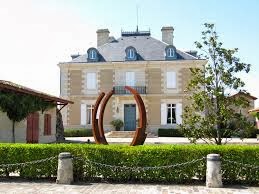The
vineyards were started in the 16th century by rich merchants from
the Pays Basque region, the Goyaneche and Daitze families. Chateau Haut-Bailly
was created in 1530, and by 1630 the property was of 36 hectares, coming into
possession by Firmin Le Bailly, a Parisian banker who gave his name to the
estate.
With the
death of Firmin the property passed to his widow and son Nicolas, and later
sold it to Jean de Caixon. Christopher de Lafaurie and his son Laurent
subsequently acquired the estate, with the latter eventually taking the
mayorship of Bordeaux. In 1736 the estate went to Thomas Barton, before coming
to Monsieur Ricard, who then sold to Alcide Bellot des Minieres in 1872.
 Alcide
made the biggest impact to the estate, reorganized and expanded the vineyards,
then building the chateau which was still standing today. The quality and
reputation soared and the prices soon matched that of the deuxieme cru. During
the phylloxera era he continued to reject the grafting of American rootstocks,
and at the beginning of the 20th century the vines were still wholly
ungrafted.
Alcide
made the biggest impact to the estate, reorganized and expanded the vineyards,
then building the chateau which was still standing today. The quality and
reputation soared and the prices soon matched that of the deuxieme cru. During
the phylloxera era he continued to reject the grafting of American rootstocks,
and at the beginning of the 20th century the vines were still wholly
ungrafted.
Alcide
died in 1906 and his wife Fanny Oliveri continued to run the estate for two
decades before selling to Franc Malvesin, who later passed to his illegitimate
children and thus through the Beaumartin family upon his death, along with a
banker named Comte Lahens.
In 1937
the Beaumartin family bought out Lahens, and the property eventually came to
George Boutemy and Jean Emile Poitevin. In 1955 it was sold to Daniel Sanders,
a Belgian merchant, and in 1979 he passed to his son Jean. In 1998 Robert
Wilmers, an American banker, acquired the estate, but keeping Daniel as general
manager, and engaging Veronique, Daniel’s granddaughter, for marketing and
administration.
Robert
invested in doing a geological survey of the vineyards, purchased new equipment
for the cuverie. The estate now accounts for 33 hectares, with a 30-hectare
single block vineyard on gravel croupe. The soils are a mixture of sand and
Tertiary gravel.
 The
vines are mainly Cabernet Sauvignon at 65%, planted on the upper parts of the
croupe and slopes, Merlot at 25% planted on the soils richer in clay, with the
remaining 10% Cabernet Franc, at a density of 10000 vines per hectare. There is
no chemical herbicide used. A special 4-hectare vineyard comprises the very
oldest vines, of the three varieties plus some Carmenere, Petit Verdot and
Malbec, all planted before 1907, representing 20% of the blend.
The
vines are mainly Cabernet Sauvignon at 65%, planted on the upper parts of the
croupe and slopes, Merlot at 25% planted on the soils richer in clay, with the
remaining 10% Cabernet Franc, at a density of 10000 vines per hectare. There is
no chemical herbicide used. A special 4-hectare vineyard comprises the very
oldest vines, of the three varieties plus some Carmenere, Petit Verdot and
Malbec, all planted before 1907, representing 20% of the blend.
The
average vine age is 35 years and the yield is around 45 hl/ha. Harvesting is by
hand, with sorting upon harvesting, destemming and finally on the vibrating
sorting table. Fermentation is in temperature-controlled vats, mostly concrete,
introduced by Professor Emile Peynaud.
 Steel
vats are used for blending, with three week cuvaison and then transfer into oak
barrels for malolactic fermentation. The elevage may last for up to 18 months,
with 50-65% new oak for each vintage. Following assemblage in stainless steel,
the wines are bottled without fining or filtration.
Steel
vats are used for blending, with three week cuvaison and then transfer into oak
barrels for malolactic fermentation. The elevage may last for up to 18 months,
with 50-65% new oak for each vintage. Following assemblage in stainless steel,
the wines are bottled without fining or filtration.
The
grand vin is Chateau Haut-Bailly, accounting for 50% of the production, with a
second wine La Prade de Haut-Bailly, accounting for 30% of the production. There
is also a third wine of the remaining 20%, sold as a generic Pessac-Leognan,
with also a limited production rose de saignee but no white.
I have
recently tasted the 2007 vintage and below is my tasting note:
Appearance
Clear, with deep ruby color core, with
garnet rims and legs.
Nose
Clean,
the nose shows medium (+) intensity aromas of black fruit such as blackcurrant,
blackberry and plum, oak notes of vanilla and cedar, pungent spice of
liquorice, maturity notes of savory and tobacco, mineral notes of earth. The
wine is developing.
Palate
Dry with
medium acidity, the wine has medium (+) tannin, smooth but still a bit grippy
in texture. Medium in alcohol, it has medium (+) body and medium (+) intensity
flavors of black fruit such as blackberry and plum, oak notes of vanilla and
cedar, MLF notes of cream, maturity notes of savory. The wine has a medium (+) finish.
Conclusion
Good
quality Pessac-Leognan with a good intense nose showing good complexity on
aromas, the wine has a balanced structure though still needing more time for the
tannin to dissolve. On the palate it has an equally impressive concentration
with reasonable complexity, with a finishing that is really long. Overall a bit
vegetal, probably due to the unripe vintage, but it is ready to drink now, and
can benefit from further ageing of another 3-5 years.


沒有留言:
張貼留言